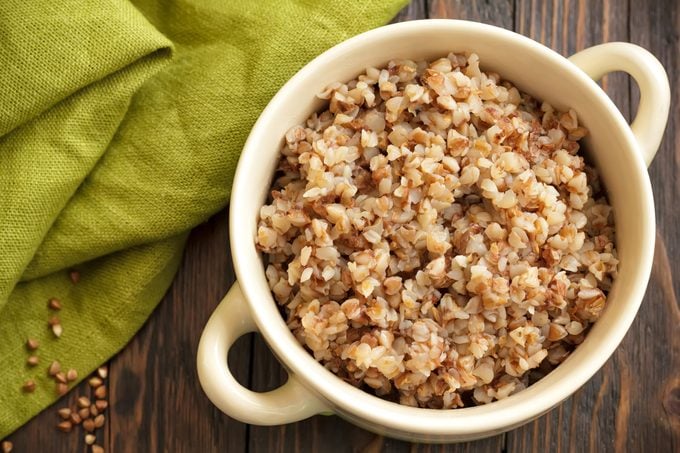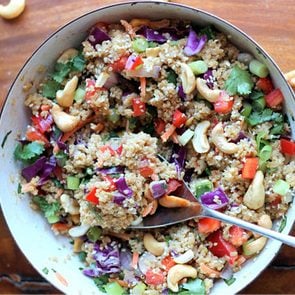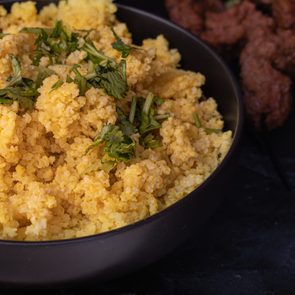Should You Eat Buckwheat Groats? Here’s Why—and How to Cook With Them
Updated: Jun. 28, 2021
Buckwheat groats are a gluten-free pseudograin high in protein, fiber, and minerals. Learn about their nutrition, benefits, and how to eat them.
What are buckwheat groats?
Buckwheat is a bit of a misnomer. There’s “wheat” in the name, sure, but the stuff doesn’t actually contain wheat. Actually, it’s not even a grain.
The pseudograin gets its name from its appearance: its grains are similar to the seeds of beech trees. “Buckwheat” comes from a Dutch word that translates to “beech wheat.”
Buckwheat groats are the hulled seeds of the buckwheat plant, which is part of the Poaceae family, according to the Oldways Whole Grain Council.
They’re naturally gluten free because, again, they’re not actually wheat. And despite not being a grain, buckwheat groats are nutritionally and culinarily very similar to grains. That’s why they’re often grouped together with whole grains like whole wheat, oats, and barley.
As for taste, “buckwheat groats taste a lot like steel-cut oats, but you can eat buckwheat groat seeds raw,” says San Diego-based registered dietitian Ashley Harpst.
Indeed, you’ll find recipes calling for both raw and cooked buckwheat groats. Some say that buckwheat tastes similar to hops.
Here’s everything you need to know about buckwheat groats, including their nutrition, health benefits, and the best way to use them.
The history of buckwheat groats
Buckwheat dates as far back as 4,000 BCE in northern China, according to 2017 research in Vegetation History and Archaeobotany. Then, around 2,000 BCE, buckwheat made its way to southwestern China and the Tibetan/Himalayan areas.
Fast forward many, many centuries—and the buckwheat crop was brought over to America by way of European colonists.
For many years, buckwheat was used in the United States mainly for flour and animal feed. In the 1970s, it started to grow in popularity, especially as a gluten-free option.
Different types of buckwheat groats
Two main types of buckwheat groats exist. These are common buckwheat (Fagopyrum esculentum) and tartary buckwheat (Fagopyrum tartaricum), per the Oldways Whole Grains Council.
The two types of buckwheat are grown differently.
Tatary buckwheat is able to self-produce using its own pollen. And because it can tolerate frost, it is able to grow in colder weather and at higher altitudes.
Common buckwheat, on the other hand, grows more in lower altitudes and is only able to reproduce with the help of insects for pollination.
As far as nutrition goes, a study in the Journal of Agricultural and Food Chemistry found that tartary buckwheat has a higher antioxidant content than common buckwheat.
The main flavonoid present in both types of buckwheat is called rutin. And in the tartary buckwheat, the rutin content is fivefold higher than in the common buckwheat.
A common use for tartary buckwheat is in soba tea, notes Berman.
Buckwheat groats nutrition
When it comes to eating buckwheat groats, exactly how much nutrition are you getting in each bite?
Here’s a look at both the numbers and the daily value (DV), using a quarter cup (45 grams) of Bob’s Red Mill Buckwheat Groats:
Calories: 160
Total Fat: 1 g (1 percent DV)
Cholesterol: 0 g (0 percent DV)
Sodium: 0 g (0 percent DV)
Carbohydrates: 33 grams (12 percent DV)
Fiber: 2 g (7 percent DV)
Protein: 6 g (12 percent DV)
Calcium: 4 mg (0 percent DV)
Iron: 1 milligram (6 percent DV)
Potassium: 196 mg (4 percent DV)

Health benefits of buckwheat
“Buckwheat became popular as a health food because of its high mineral and antioxidant content, as well as its versatility,” says Melissa Nodvin Berman, a registered dietitian in Atlanta.
Indeed, buckwheat boasts many health benefits. Here are just a few:
High in protein
One of the main perks of buckwheat groats is the protein content, with six grams per quarter cup.
“Roasted buckwheat groats can be a valuable source of protein for a plant-based diet,” says Melissa Altman-Traub, a registered dietitian nutritionist in Jamison, Pennsylvania.
And here’s a really surprising fact: buckwheat is a complete vegetarian protein, which means it contains all nine of the essential amino acids.
Only a handful of plant proteins, such as tofu, edamame, and quinoa, are considered complete proteins.
Most often, the nine essential amino acids are found in meat.
Great source of minerals
Buckwheat is an excellent source of many minerals—the B vitamins riboflavin and niacin among them.
“It is richer in minerals than other pseudocereals and supplies a good amount of zinc, copper, manganese, and magnesium compared to other cereal grains,” says Berman. “It also contains potassium, which helps maintain water and acid levels in your tissue.”
A lower-glycemic-index food
Another benefit? Buckwheat is a resistant starch, which means that it has a lower glycemic index.
“Buckwheat is mainly made of carbohydrates,” says Berman. “But these carbohydrates are lower on the glycemic index, a measure of how quickly a food raises blood sugar levels after a meal”
That may be beneficial for people with diabetes, who want to avoid major blood sugar spikes after eating. (But the seeds are still a higher-carb food, so portion control is key.)
“It is also high in fiber, which helps with digestion and satiety,” Berman says.
Because they keep you full and satisfied for a long time, buckwheat groats are said to be a beneficial grain choice for weight management. Just pay attention to portion size (more on that below).
The best ways to eat buckwheat groats
Now comes the fun part: eating buckwheat groats. You have so many options at your fingertips.
“I like to make kasha and bow ties, especially for a holiday meal, as a traditional Ashkenazic Jewish dish,” says Altman-Traub. “Also, cooked buckwheat with onions, mushrooms, and other vegetables, legumes, and herbs make a great stuffing for squash, peppers, zucchini, or eggplant.”
And raw buckwheat groats make a fantastic topper for soups and salads.
Buckwheat groats aren’t just for savory dishes. Harpst says buckwheat porridge, also called kasha, is a great breakfast option.
You can also make buckwheat smoothies, buckwheat muffins, and buckwheat cereal.
(Try these high-protein breakfast ideas.)
Risks or side effects of eating buckwheat groats
Because buckwheat groats can be eaten raw or cooked, they can be a denser grain, meaning a smaller portion size can contain a higher number of calories.
“If you are watching your calorie or carbohydrate intake, look at the portion size and see how to combine them with vegetables for less energy density,” says Altman-Traub.
If you’re using cooked buckwheat groats as a stand-in for rice, for example, consider mixing the groats with cauliflower rice to add more volume.
Berman notes that some people who consume buckwheat in large quantities may develop a buckwheat allergy.
“But overall, buckwheat is well tolerated,” she says.
How often should you eat buckwheat groats?
“They can be enjoyed regularly as part of a healthy diet in the grains group, considering guidelines such as MyPlate, the Mediterranean diet, and the Harvard Healthy Eating Plate,” says Altman-Traub.
As for serving size, Berman suggests sticking with a half-cup serving or less.
Buckwheat groats recipes to try
Ready to cook up some buckwheat? Give these recipes a try.
- Kasha Varnishkes from Joanne Weintraub via Taste of Home
- Homemade Buckwheat Groats Cereal from Kristine Duncan, MS, RDN, CDCES
- Orange Chocolate Chia Buckwheat Cereal from food blogger Rebecca Pytell
- Blueberry Buckwheat Muffins from food blogger Diana Bazic
- Berry Smoothie Bowl from food blogger Melissa Huggins
- Buckwheat Crackers from food blogger Olga Caz


















